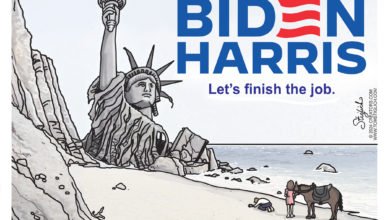These Four Key Economic Indicators Paint A Grim Picture For 2024

The newest economic indicators from the month of October point to the U.S. entering a recession at the beginning of next year as production begins to slow and investment wanes.
The Leading Economic Index (LEI), an aggregate measure of key economic components that give insight into the health and future of the economy, declined by 0.8% in October and 3.3% in the last six months, making it the 19th decline month-to-month decline in a row, according to a release from The Conference Board. The report features a number of indicators that, when aggregated together, project that the U.S. economy will soon enter a recession and that real gross domestic product will only increase by 0.8% in 2024.
“The two indicators that are most troubling are that (1) consumer expectations are low — this is a problem because consumption is 65-70% of national output — and (2) tighter credit conditions since income has not kept up with inflation and many households have exhausted their pandemic savings,” Michael Faulkender, chief economist and senior advisor for the Center for American Prosperity, told the Daily Caller News Foundation. “Therefore, they are reliant on credit to maintain their current consumption levels. Both of these point towards a pullback in economic activity, consistent with the reduction in retail sales that we saw in October.”
In a survey of consumer expectations, average Americans have increasingly been less confident about the future of the economy, which indicates that more Americans will pull back on discretionary spending in anticipation of worse financial conditions in the future, according to the University of Michigan. Consumer sentiment measured 63.8 index points in October, far lower than the 71.5 points measured in July and down from the 79 points in January 2021 when President Joe Biden first took office.
The U.S. only added 150,000 nonfarm payroll jobs in October, 30,000 less than expectations and far less than the 297,000 that were added in September, while unemployment ticked up to 3.9%. The labor force participation rate remains depressed below rates seen before the COVID-19 pandemic, reaching 62.7% in October compared to 63.3% in February 2020, according to the Federal Reserve Bank of St. Louis.
The Leading Credit Index, which uses a number of different factors to gauge how tight credit conditions are, meaning the ease Americans have in borrowing money, decreased slightly month-to-month and for the year in October, indicating tighter credit conditions, according to the LEI. The Federal Reserve has placed pressure on credit conditions, making them tighter, through its federal funds rate, which has been placed at a range of 5.25% and 5.50% in response to high inflation, which peaked at 9.1% in June 2022.
“Typically, 19 consecutive months of declines in the LEI would leave us already deep in the middle of a recession,” E.J. Antoni, a research fellow at the Heritage Foundation’s Grover M. Hermann Center for the Federal Budget, told the DCNF. “But coming out of the artificial recession in 2020 and the lingering effects thereafter, the timing of many indicators has become inconsistent. Accounting for these distortions places the beginning of a recession around year’s end.”
The rate hikes from the Fed have also influenced another indicator, the yield curve, which measures the interest rate of 10-year Treasury bonds compared to the federal funds rate and serves as a recession indicator if it is inverted as investors switch to safer securities, according to the Federal Reserve Bank of St. Louis. The yield curve has been continually inverted since July 2022 and generally inverts before recessions.
The Index for New Orders, which measures the amount being purchased by industries in anticipation of future demand, was the most negative indicator in the LEI, contributing to 1.22% of the total drop, according to the report. The decline in new orders accelerated in October, dropping to 45.5% compared to 49.2% in September, with under 50% representing a contraction, according to a report from the Institute for Supply Management.
“In terms of 2024, less than 1% annual growth is well aligned with the latest data,” Antoni told the DCNF. “The chief blame here must fall at the feet of excessive government spending. That’s what prompted the Fed to hold rates way too low for way too long, which in turn caused both inflation and a series of rate hikes, both of which have created massive distortions in the economy. Continued borrowing by the Treasury is also starving the private economy of capital, further hamstringing growth. Besides the LEI, the deep inversion of the yield curve, along with its normalization, are pointing to a recession beginning in the coming months.”
Federal debt is at an all-time high, exceeding $33.7 trillion. The debt is set to continue to grow following huge deficits from the federal government, reaching around $2 trillion for fiscal year 2023 as opposed to $1 trillion in fiscal year 2022 when Biden’s failed student loan plan is properly accounted for.
Interest on the U.S.’ sovereign debt cost the government $659 billion in fiscal year 2023 and could increase even more in 2024, according to The Washington Post. The sum was larger than the $476 billion spent on interest in 2022 and the $352 billion spent in 2021.
“Based on these recent outcomes, I would not be surprised if we were (right now) on the front end of a recession,” Faulkender told the DCNF.
The White House did not immediately respond to a request to comment from the DCNF.
Content created by The Daily Caller News Foundation is available without charge to any eligible news publisher that can provide a large audience. For licensing opportunities of our original content, please contact licensing@dailycallernewsfoundation.org




